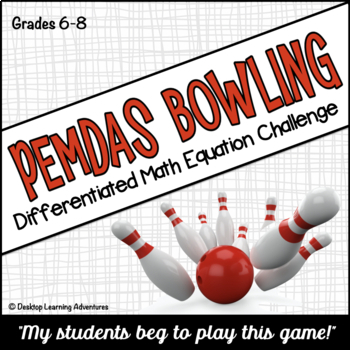Order of Operations Math Strategy Computation Bowling Game
- PDF
Also included in
- Math Games Galore Bundle is a collection of my favorite math strategy games. These year-round games are differentiated and accessible to students in 4th-8th grade. They work well in centers, as a solitaire activity when students are finished, as team challenges or homework (when you want students tPrice $9.99Original Price $13.25Save $3.26
Description
PEMDAS Computation Bowling Game is a fun order-of-operations math strategy game. If you're looking for an opportunity for students to gain math fact fluency while practicing building multi-step equations, this is it!
Your kids will enjoy the challenge of building different equations to increase their bowling scores.
Ways to use PEMDAS Bowling: Solitaire, Small Groups, or Whole Class. It makes a great go-to activity and can be used in centers or as a Problem of the Week. One teacher uses it as a daily warm-up!
With easy-to-read instructions and scoring practice activity, this game is a sure win with your kids.
Back in the 'olden days. We used to have to figure out our bowling score, but now computers do all the thinking for bowlers.For this reason, the game includes a mini-lesson on how to score in bowling.
Also included-
♦ Extensive teacher notes
♦ A shortened "How to Play" version of instructions
♦ Sample of the game being played
♦ Student pages
♦ Built-in differentiation (just added- a new scoring option if the traditional method is difficult for students)
♦ Extension ideas for data analysis
♦ Ideas for starting your very own in-class bowling league!
♥♥♥ You can also find this game as part of the bundle, Math Games Galore.
♥♥ Click HERE for additional order of operations activities.
***************************************************************************
Customer Tips:
How to get TpT credit to use on future purchases:
Please go to your My Purchases page (you may need to log in).Beside each purchase, you'll see a Provide Feedback button.Simply click it and you will be taken to a page where you can give a quick rating and leave a short comment for the product.Each time you give feedback, TpT gives you feedback credits that you use to lower the cost of your future purchases.I value your feedback greatly, as it helps me determine which products are most valuable for your classroom, so I can create more for you.
Be the first to know about my new discounts, freebies and product launches:
Look for the green star next to my store logo and click it to become a follower.Voila!You will now receive email updates about this store!
Thanks for stopping by! Pam Kranz
***************************************************************************
© Pamela Kranz Desktop Learning Adventures All Rights Reserved






